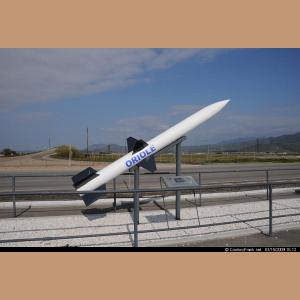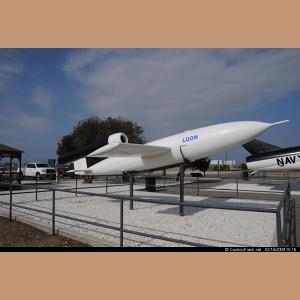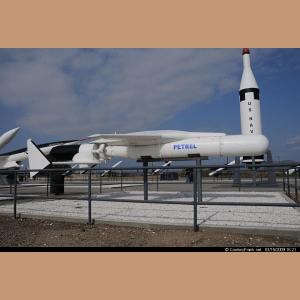Some of the missiles and planes on display at Point Mugu.
These exibits are available for viewing by the general public on State route one, just south of Oxnard, California, Wood Road exit
(about 30 miles northwest of Los Angeles)
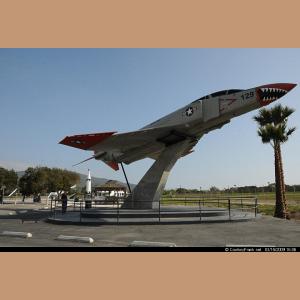 | F-4 Phantom II W The McDonnell Douglas F-4 Phantom II is one of the world's most widely used and respected military aircraft. Developed in the 1950's as a fleet defense fighter, it has since proven itself capable of growth and of taking on other missions. Today, more than 30 years after its first flight (May 1958) and more than 5,000 Phantom II's later, the F-4 serves as an air superiority fighter, attack aircraft, interceptor, defense suppression plane and reconnaissance aircraft. With current and continuous development, the Phantom II promises to be in service well into the 21st Century. Among the various nations that fly the more than 1,500 Pantom's still in service are the United States, United Kingdom, Germany, Japan, Greece, Turkey, Israel, Iran, Korea, Spain, and Egypt. Attesting to the Phantom II's superior handling and agility is the fact that for five years it was flown by the renowned U.S. Navy Blue Angles and U.S. Air Force Thunderbirds. The Phantom II has played an important part in missile test and development at Point Mugu. One of Point Mugu's tenant commands, Air Test and Evaluation Squadron Four (VX-4), flew the F-4 as its primary aircraft before transitioning to the F-14 Tomcat and F/A-18 Hornet. Currently, Phantom II's are flown as simulated targets for tracking and telemetry testing. F-4 number 157259 displayed here was delivered to the Navy on 12 December 1969 and spent several years in the Fleet. Upon transfer to Point Mugu, the aircraft was used as a platform for missile test and evaluation before being dedicated as a static display on October 1992. |
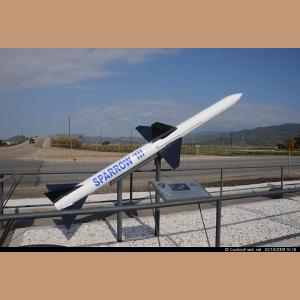 | Sparrow III W The Sparrow I & Sparrow III, along with the Sparrow II (not on display), represent approaches to developing an air-to-air missile that could replace guns and cannons on fighter aircraft. The project began in 1950 and centered around the concept of using the same engine, warehead, and control package for the three variants. Different guidance systems would be installed to make the missile a radar beam rider (Sparrow I), a fully active radar (Sparrow II), or a semi-active radar (Sparrow III). All three missiles were tested at Point Mugu, but only the Sparrow I and Sparrow III reached the fleet. Sparrow I is now obsolete, but Sparrow III in a greatly improved model is still used by fleet aircraft such as the F-14 Tomcat. The Sparrow III currently in use is 12 feet long, eight inches in diameter, and weighs 500 pounds with an 88 pound explosive warhead. It can travel at speeds in excess of Mach 2.5 at ranges up to 60 miles. |
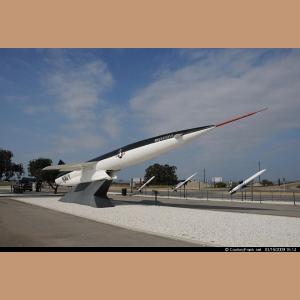 | Regulus II W The Regulus II was the Navy's first supersonic missile with nuclear capability. Starting in 1956 it underwent a highly successful test program at Point Mugu and is credited with the first delivery of mail by missile when letters were placed aboard the missle prior to an inland test flight to Edwards Air Force Base. Manufacture of the Mach 2 missile was terminated by the success of the Polaris program, and Regulus II missiles on hand were then used as targets. With a gross weight of 21,000 pounds and a wingspan of twenty feet, Regulus II was propelled by a General Electric turbojet engine producing 10,000 pounds of thrust at sea level and was assisted at launch by a detachable booster rocket. A complex mass of electronic equipment, including a UHF radio system, was used for command-control reception from ground stations and chase planes. After its target run, the Regulus II was guided to the 10,000 foot runway on San Nicolas Island by the control aircraft where it would unfold its tripod landing gear and touch down. Multiple use of the Regulus II as a target helped amortize the 2.7 million dollars each vehicle cost. The last operational Regulus II flew on target missions before it was sent to the Smithsonian Institution in Washington DC. |
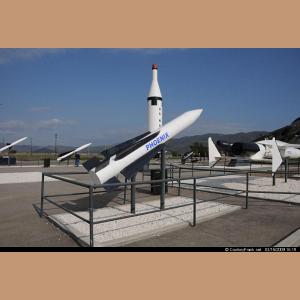 | Phoenix W The Phoenix is a long-range supersonic missile designed for air-to-air interdiction and fleet defense. Guided by its semi-active radar guidance system, the 1,000 pound Phoenix is able to track its target and chase it down at speeds to Mach 5. Using the Phoenix weapon system, the F-14 Tomcat Fighter is able to shoot down hostile aircraft at distances in excess of 120 miles, before they become a threat to the Carrier Battle Group it is protecting. As many as six Phoenix missiles can be launched from the F-14 to simultaneously attack six independent targets. The first firing of the Phoenix was conducted at Point Mugu in 1966, and since then it has undergone continuous test and evaluation to improve its accuracy and survivability. |
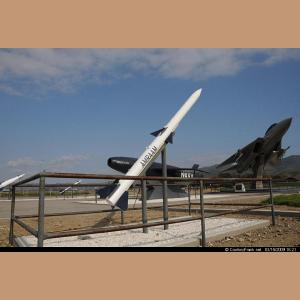 | AMRAAM W The Advanced Medium Range Air-to-Air Missile (AMRAAM) is a supersonic, medium-range weapon developed as a follow-on to the Sparrow missile family. The AMRAAM is faster, smaller, lighter and includes an on-board radar transmitter for missile active guidance. A low-smoke rocket motor, advanced proximity fuze, and enhanced electronic counter-countermeasures are also features of the system. AMRAAM is a joint US Air Force/Navy program developed by Raytheon (formerly Hughes) beginning in 1978. Point Mugu participation in AMRAAM development and operational testing began in the 1980's, and continues on a variety of improved versions of the system. First production missiles were delivered in 1990 and the first combat kill was achieved in 1991. AMRAAM is deployed on numerous aircraft including the F-15, F-16, FA-18, F-22, F-35, and a variety of allied aircraft. There is also a surface-launch variant of the missile. Production plans include over 14,000 missiles by 2015. The missile displayed here was used in pre-production testing at Point Mugu, including aircraft launcher ejection tests and airframe clearance checks. This display honors the dedicated support of all those who have made AMRAAM the warfighter's air-to-air weapon of choice in the air combat arena. |
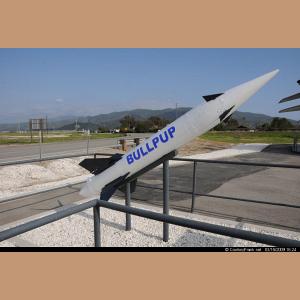 | Bullpup W The Bullpup was a supersonic air-to-air surface missile used by conventional carrier-based aircraft in close air support and for the attack of small surface targets such as bridges or supply dumps. Propelled by a solid or liquid rocket motor, the Bullpup was guided to its target by a radio link to the launch aircraft. Once launched, the pilot in the launch aircraft visually guided the Bullpup to its target using the radio link. Its range of more than three miles allowed the launch aircraft to remain outside the zone of intensive anti-aircraft fire surrounding a target. The Bullpup proved highly effective against ground targets in Viet Nam. Two versions of the Bullpup were made. The Bullpup II carried a warhead nearly twice as long as the Bullpup I. The technical evaluation of the Bullpup to determine its readiness for use in the Fleet took place at Point Mugu from 1956 to 1958. A total of 85 missiles were launched and tested before the Bullpup was released for use by the Fleet. |
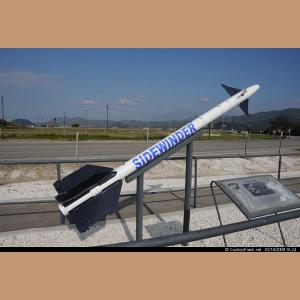 | Sidewinder W The Sidewinder is a supersonic air-to-air missile that is guided to its target by a passive infrared target detection system. The missile is sensitive enough to detect and track the heat from a cigarette - 400 degrees F, at a distance of one-quarter mile. The engine exhaust of a jet aircraft can reach more than 3,600 degrees F, and a Sidewinder will fly right up the tailpipe before exploding its high explosive proximity fuse warhead. The Sidewinder is 113 inches long, is five inches in diameter, and weighs 190 pounds. Dr. William B. McLean started development of the Sidewinder missile in 1948 at the Naval Ordnance Test Station, China Lake. The first development flight tests were made in 1951. |
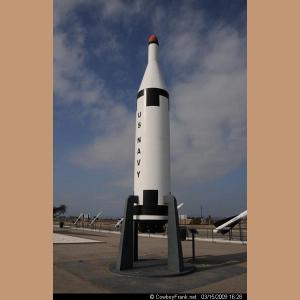 | Polaris W The Polaris is a long-range strategic missile designed to be launched from a submerged submarine. It formed the backbone of the United States submarine nuclear deterrent during most of the Cold War before being gradually replaced by newer, more modern equipment. In 1962, Point Mugu provided support for the Polaris XP-1 program which consisted of a series of four launches from the USS Observation Island with impact near Kwatalein Atoll in the South Pacific. In addition to range ships, aircraft, and installations on "downrange" islands, Point Mugu provided tests with range safety, frequency monitoring and control, launch ship precise locating, metric data during the tests and photography at the terminal phase. (Note the sign this text came from was damaged by water, some of the text was difficult to read so there may be a few errors in my typing) |
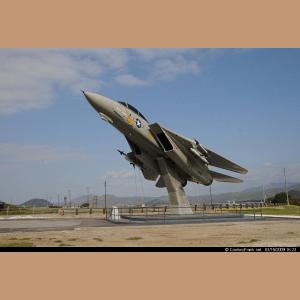 | TF-14 Tomcat W The F-14 Tomcat is a supersonic, two seat, twin-engine, swing-wing air superiority fighter designed and manufactured by Grumman Aerospace Corporation. In addition to its primary fighter role carrying AIM-7 sparrow, AIM-9 Sidewinder missiles and an internal 20 millimeter cannon, the F-14 Tomcat can also be used in fleet air defense by employing AIM-54 Phoenix missiles or as a ground attack aircraft capable of delivering a wide range of conventional munitions. F-14A bureau number 158623 was the 24th F-14 Tomcat manufactured by Grumman. The aircraft's construction began in 1971 and was accepted into the U.S. Navy's operating inventory on 14 April 1973 by fighter squadron 124 based at NAS Miramar, CA. The weapons test squadron Point Mugu, CA. On 6 July 1979 the aircraft was uniquely configured for data collection in support for F-14 research, development, test and evaluation projects. The aircraft was last flown on 8 January 1993 and has subsequently been retired from active service. The aircraft now belongs to the National Museum of Naval Aviation on permanent display here. |
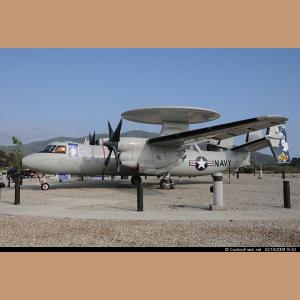 | E-2C Hawkeye W Built by Northrop Grumman Corporation and dedicated to the men and women of Naval Aviation past, present, and future. The Hawkeye is an all-weather, carriers and shore-based Airborne Early Warning and Control (AEW&C) aircraft. 41,000 pounds, length: 57 feet 7 inches, height: 18 feet 4 inches. Wingspan: 80 feet 7 inches, spread, 29 feet 4 inches folded. Two Allison T56-A-427 Turboprop engines with Hamilton Standard constant speed propellers. |
